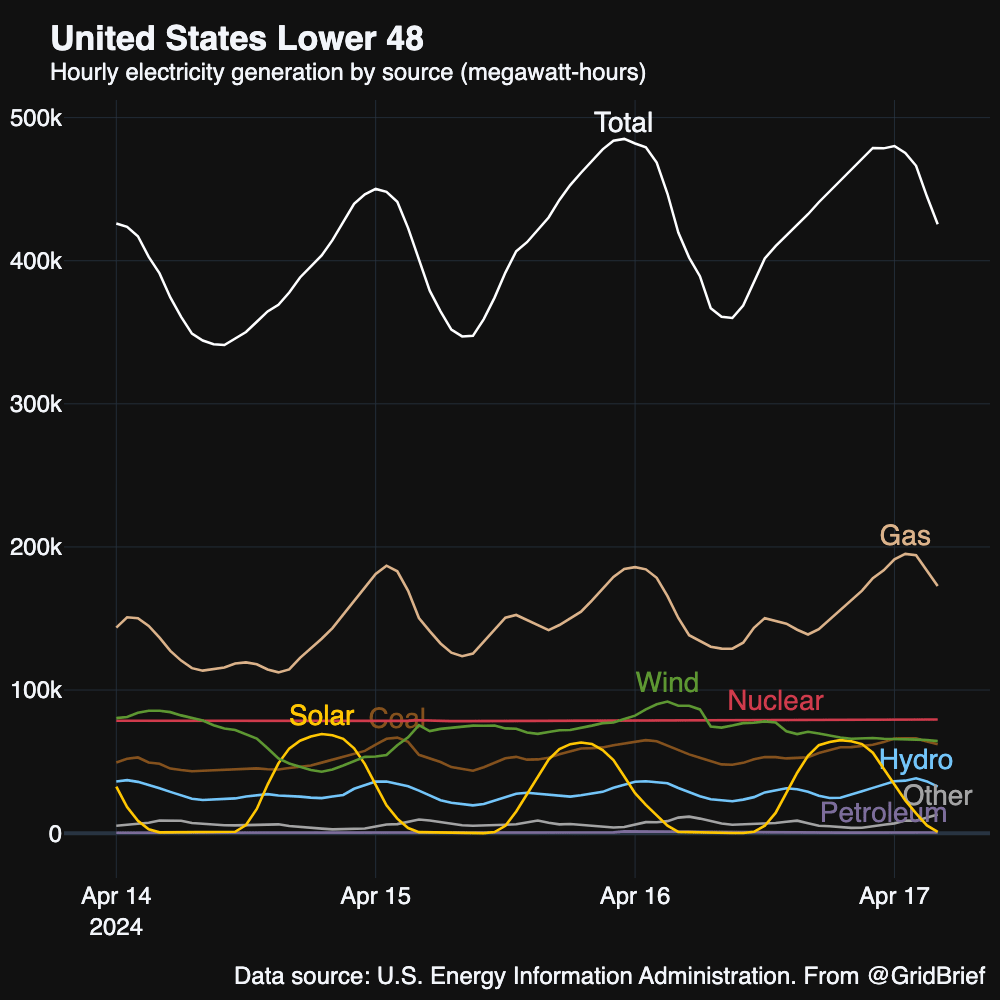Welcome to Grid Brief! Today, we’re looking at power generation in America’s traditional monopoly areas with relevant news items.
Here’s a snapshot of generation nation-wide:

Total generation increased nation-wide. Natural gas, nuclear, and wind all served as the top two national generators, with gas lifting in tandem with total generation.
Carolinas

Nuclear kept its place of pride in the Carolinas, while natural gas, coal, and solar swapped the second and third spots.
TVA

Nuclear and natural gas were the standouts in America’s largest public power entity. Hydro’s drops into the negatives were likely battery charging.
The TVA continues to face pressure from environmentalists and Congress for its plans to replace the Kingston coal plant with gas generation.
Southeast

Natural gas, nuclear, and coal kept the Southeast humming.
The Georgia Public Service Commission approved Georgia Power Co.’s plan to purchase more power and build more power plants.
“Under an agreement negotiated between the utility and commission staff, the company pledges it will credit $615 million a year in revenue toward future rate calculations in 2029 and later, even if all the new customers the company forecasts do not sign up,” reports the AP. “Georgia Power says that if nothing else changes, that amount of money could cut rates by 1.6%, or $2.89 a month, for a typical residential customer. However, the company is not guaranteeing rates will fall, because other spending could be approved in the meantime.”
Florida

Total generation fell in Florida compared to last week with the usual suspects—gas, solar, and nuclear—in the top three.
Northwest

Unlike last week, which saw a total generation drop by half, the Northwest saw generation rise steadily. Hydro and wind spent most of the week dueling for the number one spot.
Southwest

Natural gas, solar, and nuclear were the top three generators in the Southwest.
The Salt River Project, an Arizona public utility that serves 2 million customers, is partnering with corporations and non-profits to hit “a forest health goal of helping to thin 800,000 acres (323,749 hectares) by 2035.” Doing so would protect SRP’s transmission and distribution infrastructure and mitigate wildfires.
Upgrade to Grid Brief Premium to get extra deep dives into energy issues all over the world.
Conversation Starters
Biden administration throttles drilling and mining in Alaska. “The Biden administration took steps on Friday to limit both oil and gas drilling and mining in Alaska, angering state officials who said the restrictions will cost jobs and make the U.S. reliant on foreign resources, but pleasing environmentalists,” reports Reuters. “The measures are aligned with President Joe Biden's efforts to rein in oil and gas activities on public lands and conserve 30% of U.S. lands and waters to combat climate change. The Interior Department finalized a regulation to block oil and gas development on 40% of Alaska's National Petroleum Preserve to protect habitats for polar bears, caribou and other wildlife and the way of life of indigenous communities.”
Russia protects refineries from drone strikes with nets. “Russian oil company Bashneft, part of state-controlled giant Rosneft, has installed metal mesh at its refineries to protect them from drone attacks from Ukraine, Russian media reported on Friday, quoting Radiy Khabirov, the head of the Bashkortostan region where Bashneft is based. ‘We don't stop there. There are a number of solutions there, which I won't talk about yet. They are classified. But believe me, we worry about this very much,’ the Bashinform agency quoted Khabirov as saying,” reports Oilprice.com. “This year, Ukraine has intensified attacks on oil refineries in Russia, which have reduced Russian refining capacity, and which, reportedly, have the White House concerned about rising international prices.”
Democrats push for FERC transmission permitting reform. “The Federal Energy Regulatory Commission would be required to issue regulations within 18 months to give generating and storage resources faster and more cost-effective access to the grid under legislation introduced Thursday by Sen. Catherine Cortez Masto, D-Nev., and Rep. Kathy Castor, D-Fla.,” reports Utility Dive. “The bill builds on FERC’s recent reform requirements, in part by requiring transmission providers to use modeling assumptions for each resource type, such as solar and storage, based on actual operating abilities and practices when studying interconnection requests.”
Crom’s Blessing

We rely on word of mouth to grow. If you're enjoying this, don't forget to forward Grid Brief to your friends and ask them to subscribe!